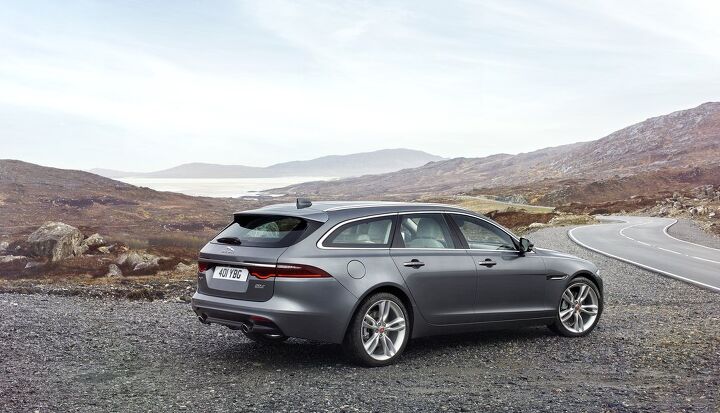Wagons Ho! What's Going on With the Station Wagon/Shooting Brake/Estate Car Market?

Ugh, you say. Wagons. A painfully uncool body type you swore off during childhood and haven’t reneged on since. A body type drooled over and feted by journalists who never put their meagre income where their mouth is. Yes, wagons. They remain part of our our automotive landscape, just a vanishingly small part of it.
But who’s buying them, and where? We have the answers.
Thanks to a study published by JATO Dynamics, we can now gauge the wagon market’s global health. As you might expect, the patient isn’t doing all that hot, but there’s promising signs of life in that market where all future automotive hopes lie: China.
But you don’t care about that, do you? You want to know that the United States accounted for 9 percent of the wagons bought in 2017. Europeans ran off with 72 percent, while the Chinese matched America’s thirst for this sometimes stodgy, sometimes gorgeous body style. More on that in a bit.
For 2018, the U.S. market picked up two lookers — the Buick Regal TourX, which General Motors has high hopes for, and the slinky Jaguar XF Sportbrake. Look for the latter wherever imported wagons are found. Which is to say, almost nowhere. A year earlier, we were welcoming the Volkswagen Golf Alltrack to the country, where it bunks with its SportWagen sibling. There’s also the recent Audi A4 Allroad to consider, and Volvo’s stunning V90 wagon will be joined by a redesigned V60 for the 2019 model year.
Mercedes-Benz is only too happy to sell American customers a wagon. Bimmer, too. Mini has a Clubman it wants you to look at. Subaru’s Outback seems assured of a long life. Suffice it to say, the market isn’t exactly on life support, but how many of these models will exist in three years? 50 percent? It’s a possibility.
JATO Dynamic’s charts show a steady decline for the wagon over the past 15 years, both in America and globally. Stateside, the take rate in 2017 was 1.4 percent, essentially unchanged from 2002. It’s not that much better on a global basis, with worldwide sales of wagons amounting to 3.1 percent of the total market in 2017. That’s down from 5.5 percent in 2002. In terms of total sales, however, wagons rose 5.7 percent last year, compared to 2016.
In the heart of the bodystyle’s biggest fan club, Europe, popularity is waning as small crossovers enter the market in greater numbers. Wagon die-hards seem to like them, but that group’s numbers aren’t rising. Still, the the body style’s market share has only dropped about 1 percent in Europe over the past 15 years (to 11.5 percent), mainly thanks to the continued support from Germany (which absorbs 37 percent of the European market’s wagon sales), and Scandinavia, where wagons represent 23 percent of total vehicle registrations. The Nordic countries account for 12 percent of European wagon sales.
Where automakers see hope for a continues wagon presence is in China, which only saw 0.9 percent of new car buyers take home a wagon in 2017. Still, that figure is vastly higher than in years past. Wagon sales in that fast-growing country rose 329 percent last year, reflecting both the introduction of various new models and the overall growth of the Chinese car market.
Stateside, there’s little doubt that the absolute saturation of the new car market with crossovers of every size and price will continue relegating wagons to a niche role. If demand was zero, though, we’d have seen the last of them years ago. It could be argued that the greater profits reaped from truck and utility vehicle sales allows automakers the flexibility to offer low-volume products like wagons.
Maybe we can all live in harmony.
[Images: Steph Willems/TTAC, Jaguar Land Rover]

More by Steph Willems
Latest Car Reviews
Read moreLatest Product Reviews
Read moreRecent Comments
- Slavuta Motor Trend"Although the interior appears more upscale, sit in it a while and you notice the grainy plastics and conventional design. The doors sound tinny, the small strip of buttons in the center stack flexes, and the rear seats are on the firm side (but we dig the ability to recline). Most frustrating were the repeated Apple CarPlay glitches that seemed to slow down the apps running through it."
- Brandon I would vote for my 23 Escape ST-Line with the 2.0L turbo and a normal 8 speed transmission instead of CVT. 250 HP, I average 28 MPG and get much higher on trips and get a nice 13" sync4 touchscreen. It leaves these 2 in my dust literally
- JLGOLDEN When this and Hornet were revealed, I expected BOTH to quickly become best-sellers for their brands. They look great, and seem like interesting and fun alternatives in a crowded market. Alas, ambitious pricing is a bridge too far...
- Zerofoo Modifications are funny things. I like the smoked side marker look - however having seen too many cars with butchered wire harnesses, I don't buy cars with ANY modifications. Pro-tip - put the car back to stock before you try and sell it.
- JLGOLDEN I disagree with the author's comment on the current Murano's "annoying CVT". Murano's CVT does not fake shifts like some CVTs attempt, therefore does not cause shift shock or driveline harshness while fumbling between set ratios. Murano's CVT feels genuinely smooth and lets the (great-sounding V6) engine sing and zing along pleasantly.



































Comments
Join the conversation
Why would you want a crossover that's squished to the ground, so it's harder to load, harder to board, and is not at all better performing?
I forgot the coolest Camry one could buy in the not to distant past was the Toyota Venza wagon. Nicely equipped, decent price, and good looks compared to a Camry sedan. I am surprised they stopped production after the 2015 model...